Katy Galli’s ‘Little Fisher Boys’ part of Camera USA 2019
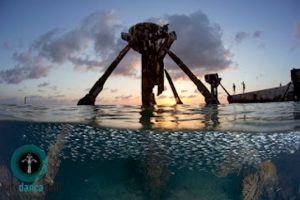 Among the photographers juried into the 2019 Camera USA National Photography Exhibition on view through July 5 in the ground floor galleries of the Naples Art Association is local photographer Katy Danca Galli, whose image, Little Fisher Boys, was also on exhibit in her May solo show at Arts for ACT Gallery in the downtown Fort Myers River District.
Among the photographers juried into the 2019 Camera USA National Photography Exhibition on view through July 5 in the ground floor galleries of the Naples Art Association is local photographer Katy Danca Galli, whose image, Little Fisher Boys, was also on exhibit in her May solo show at Arts for ACT Gallery in the downtown Fort Myers River District.
A master diver, 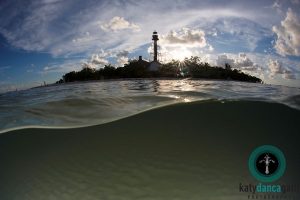 Galli is former photo editor of Scuba Diving Magazine. As the first female Lee County Resident Artist, her work has been featured with Captains for Clean Water, Bare Sports, Scuba Diving Magazine, Sport Diver Magazine and Divephotoguide.com. She has won contests with the Ocean Conservancy, NOAA, World Wildlife Federation, Our World Underwater,
Galli is former photo editor of Scuba Diving Magazine. As the first female Lee County Resident Artist, her work has been featured with Captains for Clean Water, Bare Sports, Scuba Diving Magazine, Sport Diver Magazine and Divephotoguide.com. She has won contests with the Ocean Conservancy, NOAA, World Wildlife Federation, Our World Underwater,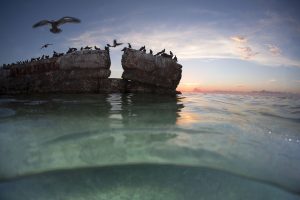 and placed first in wide angle with the Florida Skin Divers Association. She is currently working on a ‘camp and dive’ series dedicated to Florida’s waterways.
and placed first in wide angle with the Florida Skin Divers Association. She is currently working on a ‘camp and dive’ series dedicated to Florida’s waterways.
Little Fisher Boys depicts a late summer sunset in the Dry Tortugas. With the lens partially peeking above the water’s surface, it captures two little fisher boys watching for tarpon 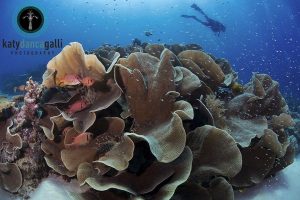 even as Galli watches for the green flash of the silver king’s immense scales in the cool, crystal waters some distance from shore.
even as Galli watches for the green flash of the silver king’s immense scales in the cool, crystal waters some distance from shore.
“Looking up from the ocean floor, the immense number of possibilities that exist in this silent realm hit me all at once,” Katy notes in her Artist Statement accompanying 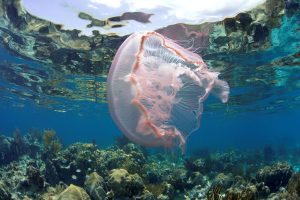 Little Fisher Boys, which goes on to observe that the ocean is subjugated by none.
Little Fisher Boys, which goes on to observe that the ocean is subjugated by none.
“[I]t can caress you, and then completely destroy you – in the span of a few seconds,” sagely points out.
Galli loves the extreme yin and yang that the underwater landscape presents, 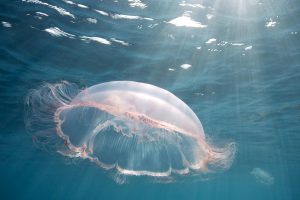 and wants others to see this in her work “and know this feeling of being both completely out of your element and then consumed by the greatest love story you’ll ever know.”
and wants others to see this in her work “and know this feeling of being both completely out of your element and then consumed by the greatest love story you’ll ever know.”
As a child, Katy grew up in an unstable, even violent and narcissistic household. Nevertheless, it was her mother 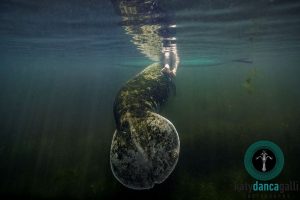 who lovingly created the predicate for her deep and abiding love of the ocean. When Katy was 10, her mother scrimped and saved up the $150 it cost for her to visit Seacamp in the Florida Keys. It was there that Katy fell in love with the ocean. She’s worked hard ever since to live and breathe by the tide.
who lovingly created the predicate for her deep and abiding love of the ocean. When Katy was 10, her mother scrimped and saved up the $150 it cost for her to visit Seacamp in the Florida Keys. It was there that Katy fell in love with the ocean. She’s worked hard ever since to live and breathe by the tide.
“Viewing a whole new 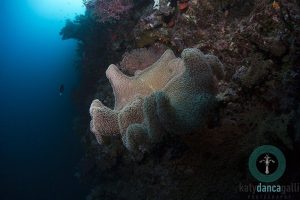 silent world at the age of 10 made me whole, and gave me firm purpose,” Katy shares.
silent world at the age of 10 made me whole, and gave me firm purpose,” Katy shares.
A sensitive child, the luxurious feel of an ocean tide, the gentle careen of a school of fish, and the vivid kaleidoscope of ocean hues quickly consumed her thoughts and sparked her imagination. From that background, she now feels a 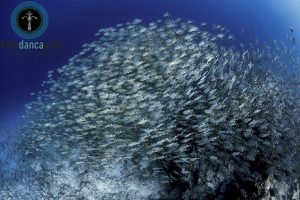 fierce sense of loyalty and protectiveness over the undersea realms she has and has yet to explore.
fierce sense of loyalty and protectiveness over the undersea realms she has and has yet to explore.
“Such beauty should be treasured and fiercely defended,” says Katy, who is committed to showing others who feel unloved and forgotten that which nature can easily cure.”
And it is 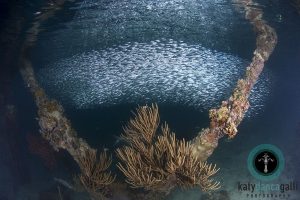 through the underwater realms that Katy photographs that she experiences God and, concomitantly, a sense of smallness and humility in comparison to the beauty and vastness to be found in the waters of the oceans and the seas.
through the underwater realms that Katy photographs that she experiences God and, concomitantly, a sense of smallness and humility in comparison to the beauty and vastness to be found in the waters of the oceans and the seas.
As is true with most photographers who focus on the natural world, Katy harbors growing concerns over the health 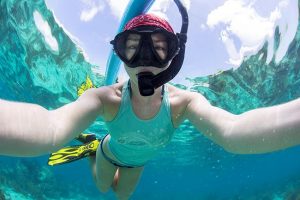 of underwater ecosystems and a fierce protectiveness of our oceans and seas, which are increasingly threatened by overfishing and climate change. The year 2018 marked the oceans’ hottest year on record, and warmer waters lead to a range of consequences from changing colors to rising sea levels to more frequent powerful storms. Carbon dioxide is also turning ocean waters acidic, and an influx of freshwater from
of underwater ecosystems and a fierce protectiveness of our oceans and seas, which are increasingly threatened by overfishing and climate change. The year 2018 marked the oceans’ hottest year on record, and warmer waters lead to a range of consequences from changing colors to rising sea levels to more frequent powerful storms. Carbon dioxide is also turning ocean waters acidic, and an influx of freshwater from 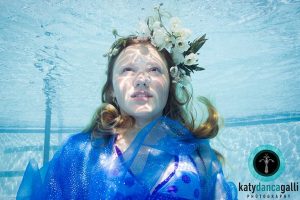 melting glaciers threatens to alter the weather-driving currents: the Atlantic Ocean’s currents have slowed by about 15 percent over the past few decades.
melting glaciers threatens to alter the weather-driving currents: the Atlantic Ocean’s currents have slowed by about 15 percent over the past few decades.
“Human activities affect nearly all parts of the ocean,” National Geographic Magazine asserts in a groundbreaking 2019 study. “Lost and discarded 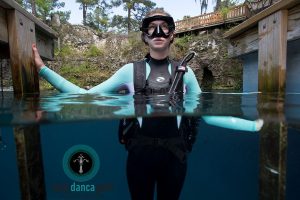 fishing nets lethally snare fish, seabirds, and marine mammals as they drift. Ships spill oil and garbage; they also transport critters to alien habitats unprepared for their arrival, turning them into invasive species. Mangrove forests are cleared for homes and industry. Our garbage—particularly plastic—chokes the seas, creating vast ‘garbage patches’ such as the Great Pacific Garbage Patch. Fertilizer
fishing nets lethally snare fish, seabirds, and marine mammals as they drift. Ships spill oil and garbage; they also transport critters to alien habitats unprepared for their arrival, turning them into invasive species. Mangrove forests are cleared for homes and industry. Our garbage—particularly plastic—chokes the seas, creating vast ‘garbage patches’ such as the Great Pacific Garbage Patch. Fertilizer  runoff from farms turns vast swaths of the ocean into dead zones, including a New Jersey-size area in the Gulf of Mexico.”
runoff from farms turns vast swaths of the ocean into dead zones, including a New Jersey-size area in the Gulf of Mexico.”
The greed reflected by wanton consumption and the associated fear of the unknown tumult being inflicted on our oceans and seas is a constant worry for Galli. “The ruin that has begun … bend[s] my heart,” Katy remarks. “This is a sacred place, and my tenacity and blood will run into her darkest depths before I have finished teaching the ignorant of her beauty, showing the blind strength to be gained from her splendor, and worshipping every interaction with the blessed shores I am still free to have and hold.”
Camera USA 2019 closes on July 5. But before then, you can see the show in the ground floor galleries of the Naples Art Association.
July 1, 2019.














 Tom Hall is both an amateur artist and aspiring novelist who writes art quest thrillers. He is in the final stages of completing his debut novel titled "Art Detective," a story that fictionalizes the discovery of the fabled billion-dollar Impressionist collection of Parisian art dealer Josse Bernheim-Jeune, thought by many to have perished during World War II when the collection's hiding place, Castle de Rastignac in southern France, was destroyed by the Wehrmacht in reprisal for attacks made by members of the Resistance operating in the area. A former tax attorney, Tom holds a bachelor's degree as well as both a juris doctorate and masters of laws in taxation from the University of Florida. Tom lives in Estero, Florida with his fiancee, Connie, and their four cats.
Tom Hall is both an amateur artist and aspiring novelist who writes art quest thrillers. He is in the final stages of completing his debut novel titled "Art Detective," a story that fictionalizes the discovery of the fabled billion-dollar Impressionist collection of Parisian art dealer Josse Bernheim-Jeune, thought by many to have perished during World War II when the collection's hiding place, Castle de Rastignac in southern France, was destroyed by the Wehrmacht in reprisal for attacks made by members of the Resistance operating in the area. A former tax attorney, Tom holds a bachelor's degree as well as both a juris doctorate and masters of laws in taxation from the University of Florida. Tom lives in Estero, Florida with his fiancee, Connie, and their four cats.